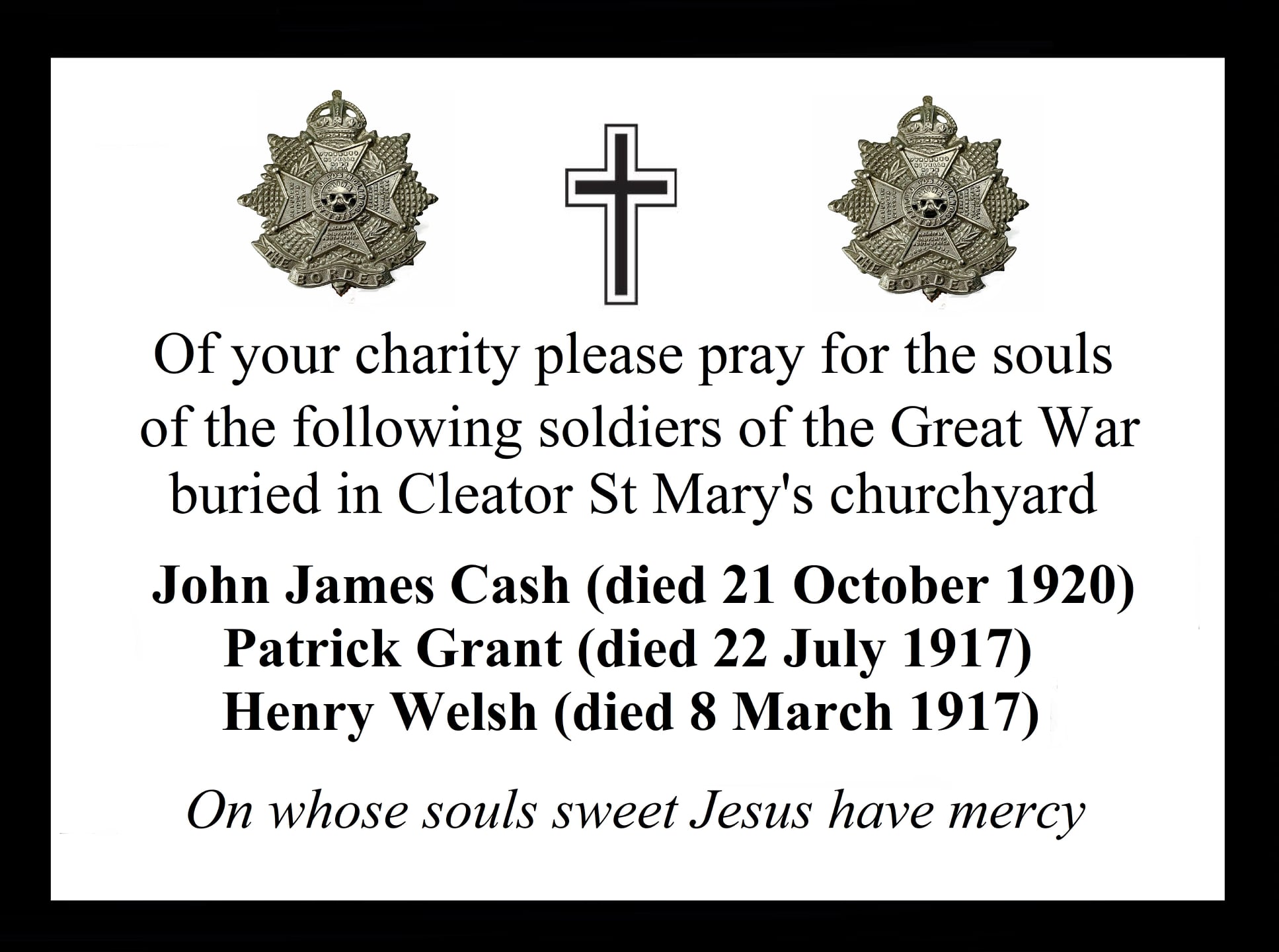Three Moor Men ,100 years On Still Awaiting the Recognition of their Sacrifice by Joe Ritson
Posted on 9th Nov 2021
Three of the soldiers from the Cleator Moor area who died during the so called 'Great War' and honoured by the Cleator Moor Roll of Honour are known to have their final resting place in St Mary's churchyard, Cleator although their graves are unmarked. These three young men, John James Cash, Patrick Grant and Henry Welsh all served with the Border Regiment. Until recently, none of these three were recognised as war casualties by the War Graves Commission and so have never had an official headstone or memorial.
Corporal Cash, still a serving soldier at the time, died at Netley Hospital, Southampton in 1920. He was 19 years old. Netley hospital was where Reverend Caesar Caine, Anglican Vicar of Cleator had earlier served as a military chaplain (1917-1919). Corporal Cash was from Bowthorn Road, Cleator Moor and the burial register of St Mary's parish shows that he was buried in the churchyard a few days later although the location is unknown. While the CWGC now accept Corporal Cash as an official casualty the commission states they require further additional documentary evidence to prove the burial at Cleator was the soldier who died at Southampton before they would apply to erect and maintain a headstone. A contemporary memorial prayer card or newspaper report would have been useful for this purpose but neither of these has ever been found.
Patrick Grant, from Birks Road Cleator Moor, was one of two brothers who died in the war. They enlisted to the Border Regiment in September 1914. Patrick's brother James Grant died during the Battle of Ancre on the Somme in September 1916. Both Patrick and James Grant had earlier served with the 6th Border Regiment in the Gallipoli campaign. Patrick Grant was discharged from the army on medical grounds in March 1917 (no longer fit for military service) and died at home in Cleator Moor in July 1917. According to the parish burial register Patrick Grant was buried in St Mary's churchyard on 24 July 1917. As of November 2021 Patrick Grant is not recognised as a war casualty by the War Graves Commission. In 2019 the Cleator Moor WW1 project team submitted his case for inclusion as a war casualty but still awaiting a reply.
Henry Welsh of Fletcher Street, Cleator Moor enlisted to the Border Regiment in September 1914 and served on the Western Front in France in 1915, where he was badly gassed and taken to the Canadian Red Cross Military Hospital at Taplow, Buckinghamshire for treatment. As with the situation with Patrick Grant, Henry Welsh was another soldier eventually discharged on medical grounds as no longer fit for military service. He died at home in March 1917 and the St Mary's parish burial register records Henry was buried in the churchyard but again the exact location has been lost. Again, as with Patrick Grant, the War Graves Commission does not recognise Henry Welsh as a war casualty and so does not have an official CWGC headstone or memorial in the churchyard. His case for inclusion as an official war casualty was submitted to the CWGC in 2019 by the Cleator Moor WW1 project team but as of November 2021 a decision by the Commission is still pending.
Although these three Cleator Moor soldiers do not have official CWGC headstones to mark their final resting place, Corporal John James Cash is now remembered in the United Kingdom Book of Remembrance maintained by the commission. His name is not on the parish war memorial for WW1 found inside St Mary's church as that memorial was unveiled and dedicated shortly before Corporal Cash's death. Private Patrick Grant and Private Henry Welsh, who both died in 1917, are commemorated on the St Mary's parish war memorial and of course, all three are remembered by the Cleator Moor Roll of Honour.
Especially from the WW1 years there remain many thousands of service men and women (or ex-service men and women) who died as a result of the war and are not commemorated by the Commonwealth War Graves Commission. It is possible to submit a case to the Commission for a casualty to be included but this is not an easy process and definitely not a speedy one. For example many of the documents that the Commission say they required to "prove" irrefutably a discharged soldier's death was directly due to his or her military service may have been destroyed, such as the service record and discharge papers.
Even when a casualty has been officially accepted by the Commission for them to agree to erect one of their headstones they say they require more than just a Catholic parish church burial register (such as St Mary's Cleator) which tends not to include the occupation or place of death of the deceased person. A burial record in a civil cemetery, such as at Egremont or Whitehaven for example, usually records the place of death, occupation and a few other details. That would be enough evidence to be accepted by the Commission and they would agree to erect a headstone.
Whether or not the men and women who served in the Armed Forces and paid the ultimate sacrifice are recognised by the War Graves Commission they should be, and are, remembered and honoured forevermore, especially in their own home locality. May we always remember these and the other sons and daughters from the Cleator and Cleator Moor area and speak of them with gratitude and fondness.
Lest we forget
